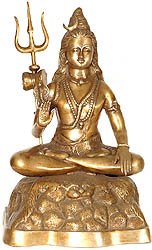
The five mantras that constitute Shiva's body are
Sadyojaata, Vaamadeva, Aghora, Tatpurusha and Eesaana.
Sadyojaata - earth Vaamadeva - water Aghora - fire Tatpurusha - air Eesaana - space
Vishnudharmottara Purana of the 6th century face an element to each of the above mantras
Mahadeva (earth) Bhairava (fire) Nandi (air) Uma (water) Sadasiva (space)
Shiva is referred to as 'the good one' or the 'auspicious one'.
Shiva - Rudra is considered to be the destroyer of evil and sorrow
Shiva - Shankara is the doer of good
Shiva - Nataraja is the Divine Cosmic Dancer
Shiva - Ardhanareeswara is both man and woman
Shiva is 'tri netra' or three eyed, and is 'neela kantha' - blue necked (having consumed poison to save the world from destruction.
He is both static and dynamic and is both creator and destroyer.
He is the oldest and the youngest, he is the eternal youth as well as the infant.
He is the source of fertility in all living beings.
He has gentle as well as fierce forms.
Shiva is the greatest of renouncers as well as the ideal lover.
He destroyes evil and protects good.
He bestows prosperity on worshipers although he is austere.
He is omnipresent and resides in everyone as pure consciousness.
Shiva is inseparable from Shakti - Parvati the daughter of Himavaan - Haimavati.
There is no Shiva without Shakti and no Shakti without Shiva, the two are one - or the absolute state of being - consciousness and bliss.

